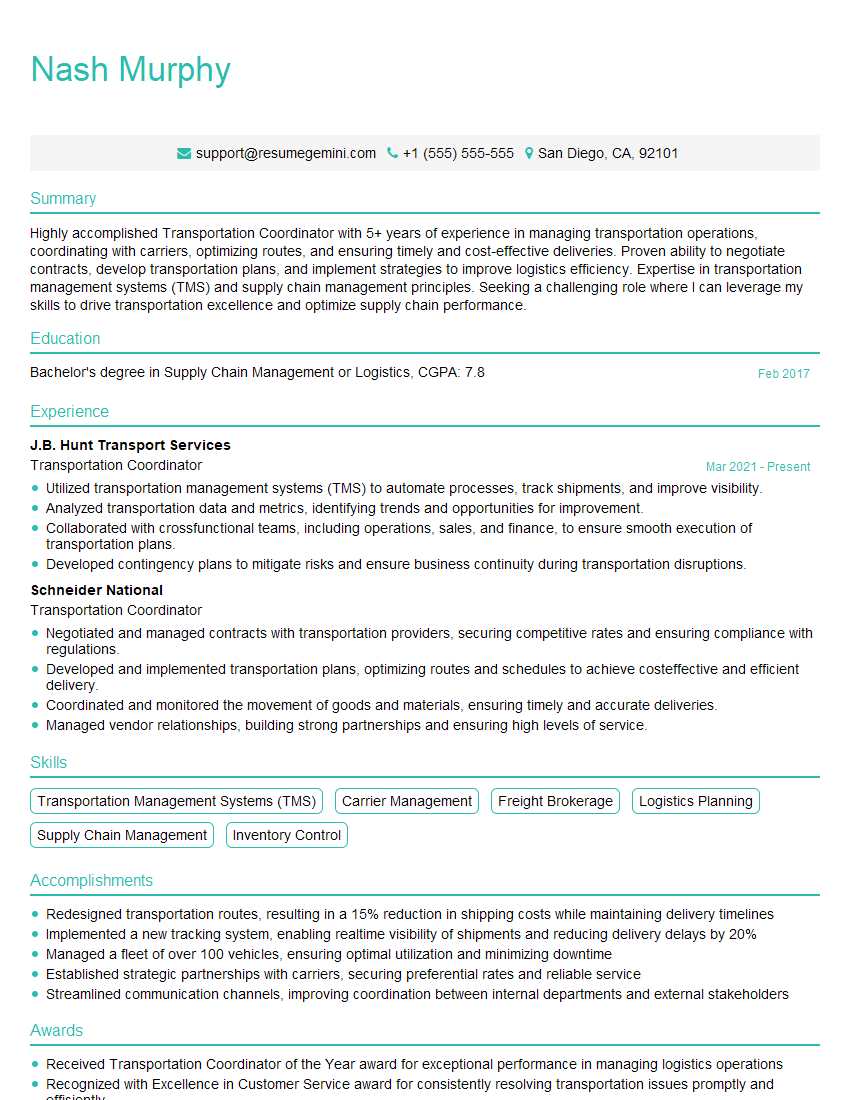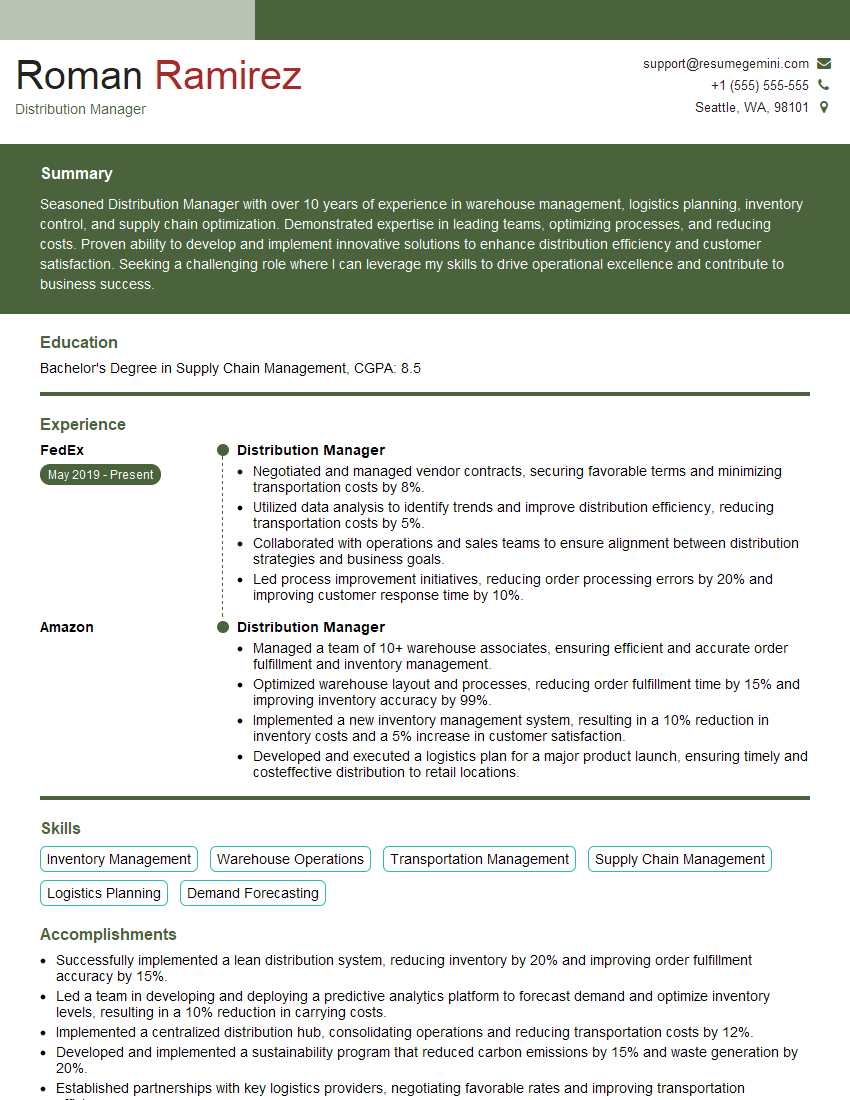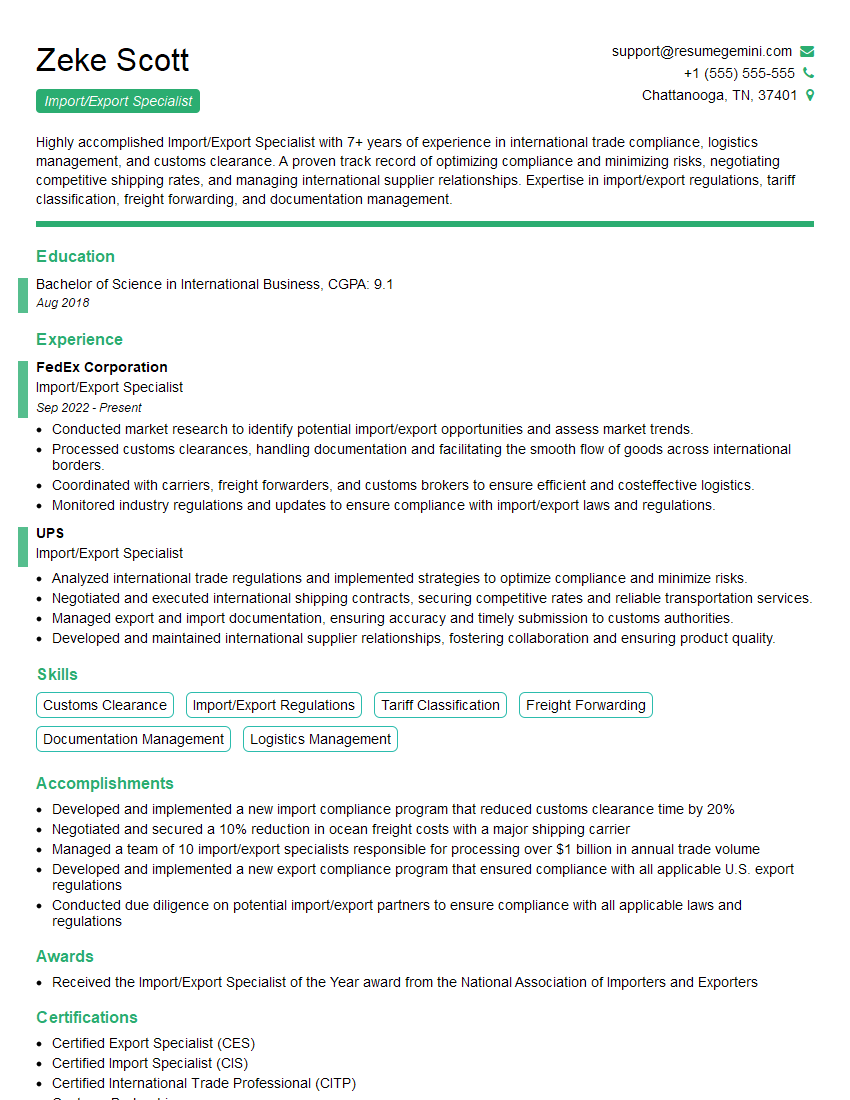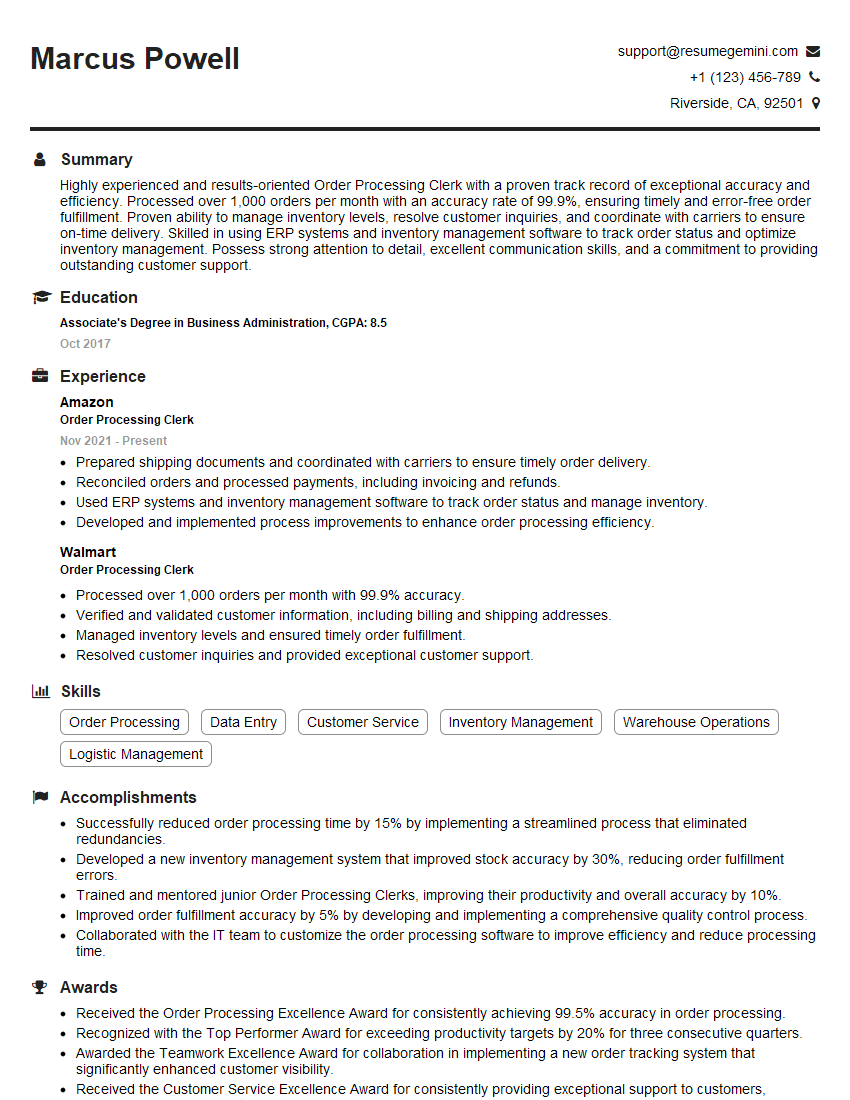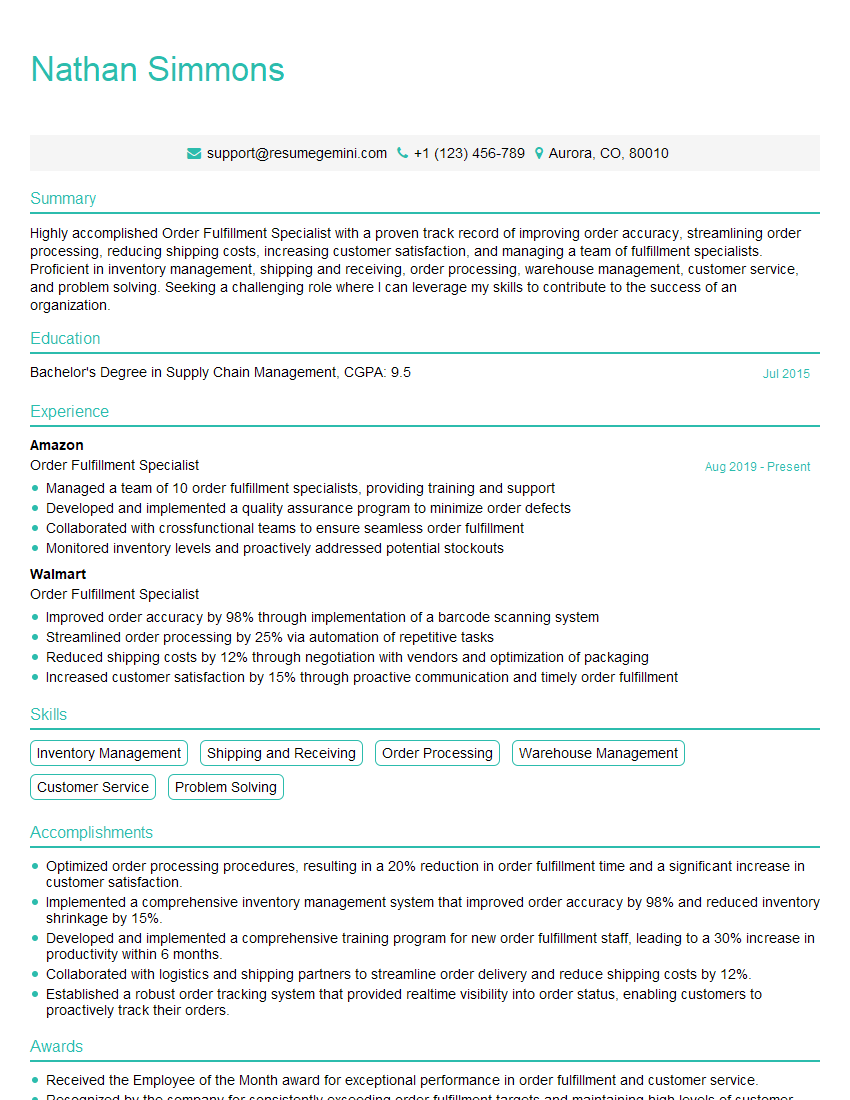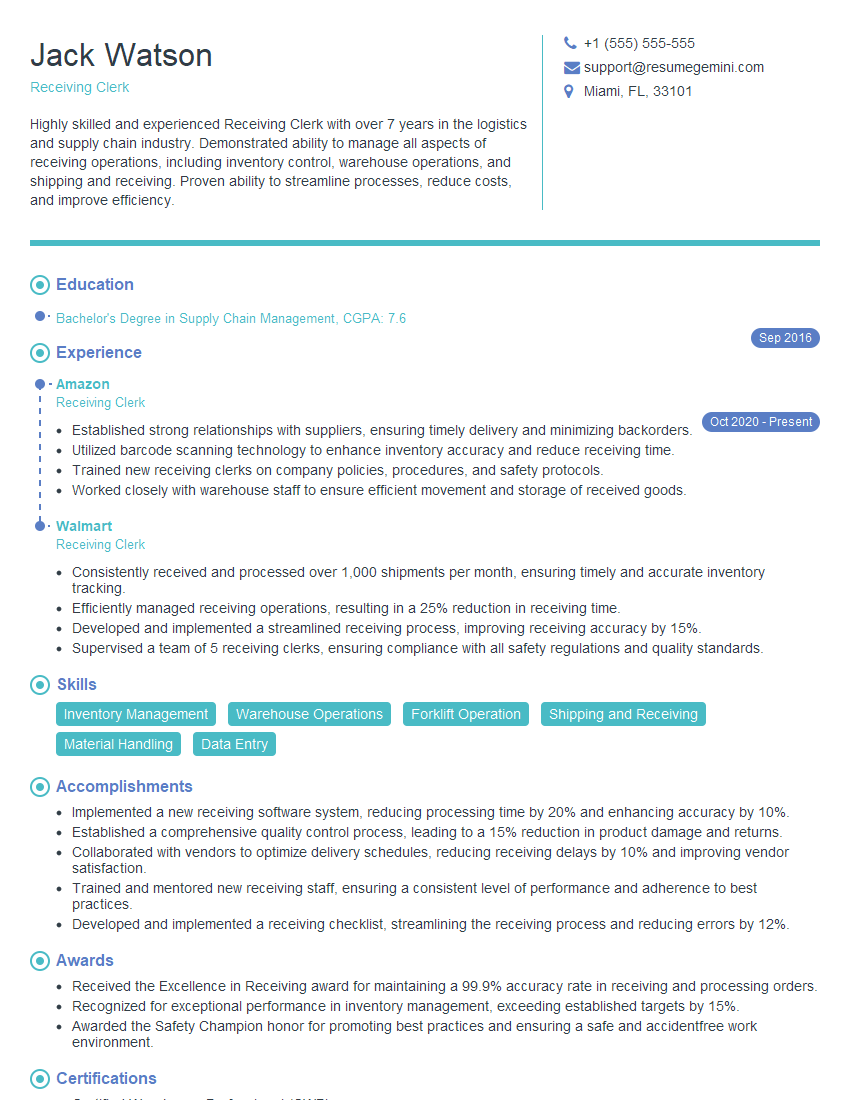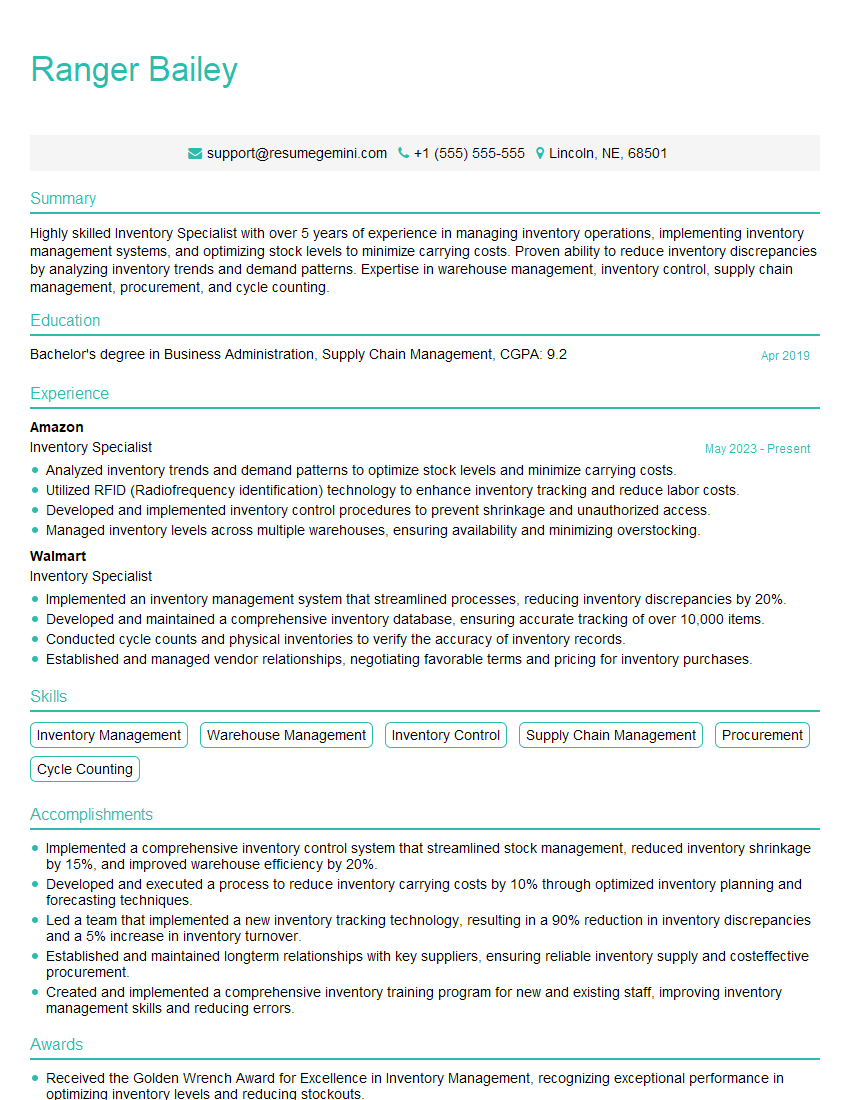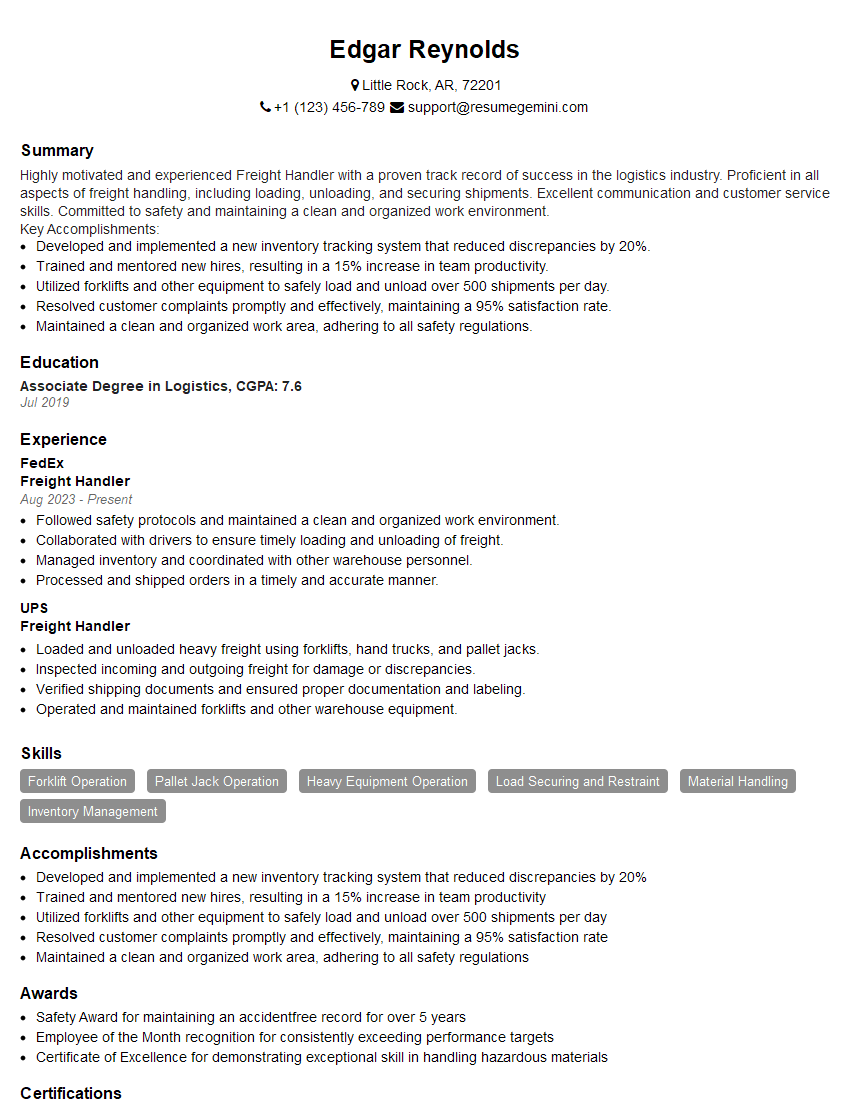Are you ready to stand out in your next interview? Understanding and preparing for Reading and Interpreting Shipping Labels interview questions is a game-changer. In this blog, we’ve compiled key questions and expert advice to help you showcase your skills with confidence and precision. Let’s get started on your journey to acing the interview.
Questions Asked in Reading and Interpreting Shipping Labels Interview
Q 1. What are the key components of a shipping label?
A shipping label is the crucial communication piece conveying essential information about a package throughout its journey. Think of it as the package’s passport! Key components include:
- Sender’s Address: Complete address, including name, street address, city, state/province, postal code, and country.
- Recipient’s Address: The same detailed information as the sender’s address, ensuring accurate delivery.
- Tracking Number: A unique alphanumeric code allowing for real-time tracking of the package’s location.
- Shipping Service/Carrier Information: Clearly identifies the shipping company (e.g., FedEx, UPS, USPS) and potentially the chosen service type (e.g., Express, Ground).
- Package Weight and Dimensions: Essential for pricing and handling. Often shown as weight (e.g., 2 lbs) and dimensions (e.g., 12x10x8 inches).
- Special Handling Instructions: Indicates any special requirements like ‘Fragile,’ ‘Handle with Care,’ ‘Perishable,’ or other relevant instructions.
- Barcode: A machine-readable code containing essential information, facilitating automated sorting and processing.
- Customs Information (for international shipments): Includes declarations of contents, value, and origin for customs clearance.
For example, a label missing the recipient’s address would lead to significant delays or even prevent successful delivery. Each component plays a vital role in ensuring smooth and efficient shipment.
Q 2. Explain the significance of the tracking number on a shipping label.
The tracking number is the lifeblood of a shipment, providing visibility into its journey. It’s a unique identifier assigned to each package, enabling real-time tracking through the carrier’s website or app. Imagine trying to find a specific grain of sand on a beach – the tracking number is like that grain’s unique fingerprint, allowing you to locate it amongst millions. By entering the tracking number, you can see where the package is currently located, its estimated arrival time, and any significant events (e.g., scanned at a sorting facility, out for delivery). This information is crucial for both the sender and the recipient, providing peace of mind and facilitating proactive problem-solving in case of delays or issues.
For instance, if a package is delayed, the tracking number allows you to contact the carrier and investigate the reason for the delay. This allows for timely intervention and prevents potential losses or inconveniences.
Q 3. How do you identify the origin and destination of a shipment from a label?
The origin and destination are clearly displayed on the shipping label, typically as part of the sender’s and recipient’s addresses. The sender’s address indicates where the package originated, while the recipient’s address shows where it’s destined. For example:
Sender: John Doe, 123 Main St, Anytown, CA 91234, USARecipient: Jane Smith, 456 Oak Ave, Somewhere, NY 10001, USA
In this example, Anytown, CA is the origin, and Somewhere, NY is the destination. International shipments would include country codes to make the origin and destination fully clear. Missing or incorrect addresses are frequent causes of shipping delays or misdeliveries, underscoring the importance of accurate information on the label.
Q 4. What are the different classes of mail and how are they indicated on labels?
Shipping labels often indicate the class of mail, which determines the handling, speed, and cost of shipping. The specific indicators vary depending on the carrier, but common examples include:
- First Class Mail (USPS): Usually indicated by the service type printed on the label. This is often used for letters, postcards, and small packages.
- Priority Mail (USPS): Similar to First Class, this is another USPS service indicated directly on the label. This service offers faster delivery than First Class.
- Express Mail (USPS): The fastest USPS option, clearly denoted on the label.
- Ground Shipping (UPS, FedEx): A less expensive, slower service typically used for heavier or larger packages.
- Express Shipping (UPS, FedEx): Similar to Express Mail, this indicates a faster, more expensive service for urgent shipments.
The class of mail directly impacts the shipping cost and delivery speed. Understanding this information is crucial for managing expectations and choosing the most appropriate service for a particular shipment.
Q 5. How do you interpret hazardous materials labeling?
Hazardous materials labels adhere to strict regulations (like those set by the UN and IATA) and require specific, standardized markings. These labels clearly identify the type of hazard and often use pictograms (symbols) for quick visual identification. Failure to correctly label hazardous materials can have serious consequences. Common features include:
- Hazard Class and UN Number: Identify the specific type of hazardous material (e.g., flammable liquid, corrosive substance). The UN number is a globally unique identifier.
- Pictograms: Standardized symbols illustrating the hazard (e.g., flame for flammables, skull and crossbones for toxic substances).
- Signal Words: Words like ‘Danger’ or ‘Warning’ indicate the severity of the hazard.
- Additional Information: May include technical names, emergency contact information, and handling precautions.
For example, a package labeled with a flame pictogram and a UN number associated with flammable liquids requires special handling to prevent fire or explosion. Proper identification prevents accidents and ensures safe transportation.
Q 6. What does ‘Fragile’ or ‘Handle with Care’ signify on a label?
‘Fragile’ or ‘Handle with Care’ labels indicate that the package contains breakable or easily damaged items. These labels alert handlers to exercise extra caution when moving and sorting the package to prevent damage during transit. These are not simply suggestions; they are crucial instructions to avoid costly damage to goods.
Imagine sending a delicate piece of art. Labeling it ‘Fragile’ ensures it’s handled with the care it deserves, reducing the risk of breakage and ensuring it reaches its destination undamaged. The lack of such a label can lead to damage claims and lost revenue.
Q 7. How do you determine the weight and dimensions of a package from its label?
The weight and dimensions of a package are usually clearly stated on the shipping label. This information is vital for pricing and handling. For example, a label might show:
Weight: 5 lbs (2.27 kg)Dimensions: 18x12x6 inches (45.7x30.5x15.2 cm)
The weight is crucial for calculating shipping costs, while the dimensions help determine if the package can fit on certain conveyances and whether it requires special handling (e.g., oversized items). Accurate weight and dimensions are critical for efficient logistics and to prevent surcharges due to incorrect information.
Q 8. How do you identify the shipping carrier from the label?
Identifying the shipping carrier from a label is usually straightforward. The carrier’s logo is prominently displayed, often alongside their tracking number format. For example, a label with a distinctive brown color and the FedEx logo clearly indicates FedEx as the carrier. Similarly, a label featuring a blue and white color scheme and the UPS logo signifies a UPS shipment. USPS labels usually have a distinctive red, white, and blue color scheme and the USPS logo. If the logo isn’t immediately apparent, look at the tracking number itself – the structure of the tracking number often hints at the carrier. For instance, USPS tracking numbers usually begin with ’92’ or ’94’, while UPS tracking numbers often start with ‘1Z’. FedEx numbers have a distinct alphanumeric structure that’s easy to recognize after seeing a few.
Q 9. What are the common abbreviations and symbols used on shipping labels?
Shipping labels are packed with abbreviations and symbols to convey a lot of information concisely. Some common abbreviations include: FRAGILE (handle with care), UP (indicates the package should be placed upright), HANDLE WITH CARE, THIS SIDE UP, and various country codes (e.g., US for the United States, CA for Canada). Symbols often include arrows indicating orientation, or icons representing hazardous materials (e.g., a flame symbol for flammable goods). Understanding these markings is crucial for proper handling during transit. For example, a package marked FRAGILE and an arrow pointing upwards will need to be handled with extra caution and kept upright.
Q 10. What actions do you take if a shipping label is damaged or illegible?
A damaged or illegible shipping label is a significant problem. My first step is to carefully assess the damage. If any information remains readable, I note it down. Then, I attempt to locate any additional documentation associated with the shipment – a packing slip, an invoice, or even an email confirmation might contain the necessary information. If I cannot locate any additional documentation, I escalate the issue to the shipping carrier immediately. They usually have mechanisms for handling damaged labels, and potentially reconstructing the information. In some cases, this might involve contacting the sender for clarification.
Q 11. How do you handle discrepancies between the label information and the physical package?
Discrepancies between label information and the physical package are a serious concern. This could range from a weight mismatch to an incorrect item description. My immediate response is to carefully document the discrepancies – taking photos as evidence. Next, I verify the label information against any available documentation, such as the packing slip. If the discrepancies cannot be resolved quickly, I contact the shipping carrier and potentially the sender to clarify the issue and determine the best course of action. This usually involves explaining the situation, presenting the evidence (photos of discrepancies), and requesting instructions on how to proceed.
Q 12. Describe your experience with different types of shipping labels (e.g., USPS, FedEx, UPS).
I have extensive experience with USPS, FedEx, and UPS labels. Each carrier has its own specific format and requirements. USPS labels are often simpler, focusing on the address and postage information. FedEx and UPS labels are more sophisticated, often including additional information such as service type, dimensions, and reference numbers. I’m familiar with how to generate each label, interpret their specific data fields, and understand any carrier-specific requirements for hazardous materials or international shipping. I’ve handled thousands of labels across all three carriers and can confidently identify and understand the information provided.
Q 13. How do you ensure the accuracy of shipping label information?
Ensuring accurate shipping label information is paramount. I meticulously check every piece of data: the sender and recipient addresses, including postal codes; the weight and dimensions of the package; the service type selected; and any special handling instructions. I cross-reference this information with the packing slip and any other supporting documentation. Using label generation software helps in this process as the software often provides alerts for potential errors. I always double-check the address information using an online address verification tool, to minimize the risk of errors. By using this methodical approach, the chances of errors are significantly reduced.
Q 14. How familiar are you with international shipping labels and regulations?
I am very familiar with international shipping labels and regulations. International shipping involves a more complex set of rules and regulations due to customs declarations, different address formats, and varying carrier requirements. I understand the importance of accurately completing customs forms and including the Harmonized System (HS) codes for the goods being shipped. I’m also aware of the different documentation requirements, restrictions on certain goods, and the potential for delays due to customs inspections. I’ve worked extensively with international shipments to various countries, understanding their unique documentation and regulatory requirements and can navigate these complexities confidently. For example, I’m familiar with the required documentation for shipping to the European Union and the specific requirements for various countries in Asia and South America.
Q 15. What software or systems have you used to generate or process shipping labels?
Throughout my career, I’ve utilized a variety of software and systems for generating and processing shipping labels. This ranges from simple desktop applications like those offered by major carriers like FedEx and UPS, to more sophisticated enterprise resource planning (ERP) systems integrated with our warehouse management system (WMS). For example, I’ve extensively used UPS WorldShip for generating labels, tracking shipments, and managing returns. I’m also proficient with Shopify’s shipping label integration, which streamlines the process for e-commerce orders. In larger-scale operations, I’ve worked with systems like Oracle Transportation Management, which automates label generation based on order data and allows for centralized management of shipping processes. Each system offers unique features, but the core function remains the same: to accurately create labels containing all necessary shipping information.
Career Expert Tips:
- Ace those interviews! Prepare effectively by reviewing the Top 50 Most Common Interview Questions on ResumeGemini.
- Navigate your job search with confidence! Explore a wide range of Career Tips on ResumeGemini. Learn about common challenges and recommendations to overcome them.
- Craft the perfect resume! Master the Art of Resume Writing with ResumeGemini’s guide. Showcase your unique qualifications and achievements effectively.
- Don’t miss out on holiday savings! Build your dream resume with ResumeGemini’s ATS optimized templates.
Q 16. Explain the importance of verifying shipping labels before dispatch.
Verifying shipping labels before dispatch is paramount to avoid costly and time-consuming errors. Think of it like proofreading a crucial document before sending it – a small mistake can have significant consequences. Incorrect addresses lead to delays, returns, and potentially lost packages. Incorrect weight or dimensions can result in additional shipping charges or even rejected shipments. Missing or inaccurate customs declarations can cause delays or seizures for international shipments. My verification process involves carefully checking every detail: the recipient’s full address, including postal code and any special delivery instructions; the weight and dimensions, comparing them to the package itself; the correct service selected, ensuring it matches the required delivery speed and insurance level; and finally, reviewing any customs information for international shipments. A meticulous approach minimizes errors and ensures smooth delivery.
Q 17. How do you manage a high volume of shipping labels efficiently?
Managing a high volume of shipping labels efficiently requires a systematic approach. Automation is key. We utilize label printing software integrated with our order management system. This automatically generates labels based on order details, eliminating manual data entry and reducing human error. Batch processing allows us to print multiple labels simultaneously. We also employ a color-coded system for prioritizing shipments, for instance, using different colored labels to indicate express deliveries or fragile items. Furthermore, we regularly audit our processes to identify bottlenecks and optimize workflow. A well-trained team is crucial; each team member is responsible for a specific aspect of label generation and verification, creating a streamlined assembly line. Finally, using barcode scanners helps expedite the matching of labels with packages ensuring accuracy and speed.
Q 18. What is your process for resolving shipping label errors?
My process for resolving shipping label errors begins with identifying the nature of the mistake. This could range from a simple typographical error in an address to more complex issues like incorrect service selection or missing customs documentation. For minor errors like typos, corrections can often be made directly on the label if the carrier allows. For major errors, I immediately contact the carrier’s customer service to discuss options. This might involve reprinting a corrected label or making arrangements for a package redirect. Accurate record-keeping is essential. I document all errors, corrective actions, and communication with carriers. This data assists in identifying recurring issues and improving our processes to prevent future errors. In some cases, where a label is irretrievably damaged, we might need to generate a new label and re-route the package.
Q 19. Describe a situation where you had to decipher a difficult or ambiguous label.
I once received a package with a severely damaged label; the ink was smudged, and parts were torn. It was an international shipment, and the address was barely legible. My approach was systematic. I carefully examined the remnants of the address, piecing together the information. I used online tools to search for possible matches based on the partial address and the origin country indicated by the carrier’s markings. I contacted the sender to verify the details. Through a combination of careful observation, investigative research, and communication, I successfully identified the correct recipient and ensured the package arrived at its destination. This situation highlighted the need for robust label quality and the importance of having backup contact information.
Q 20. How do you prioritize tasks when dealing with multiple shipping labels?
Prioritizing shipping labels often involves a combination of factors. Time-sensitive deliveries, like those marked ‘express’ or with specific delivery deadlines, take precedence. Fragile or temperature-sensitive items also demand immediate attention. High-value packages require careful handling and verification. I use a ticketing system to manage all tasks, assigning priorities based on these criteria. The system alerts me to impending deadlines, ensuring timely processing of urgent shipments. We use a combination of urgency and due date to prioritize, ensuring that the most time-sensitive shipments are handled first. This ensures that deadlines are met, minimizing the risk of delays and customer dissatisfaction.
Q 21. What safety precautions do you follow when handling packages based on label information?
Safety is paramount when handling packages, and the shipping label provides crucial information to guide safe handling practices. If a label indicates ‘fragile,’ I handle the package with extra care, avoiding rough movements or stacking it with heavier items. Labels indicating hazardous materials necessitate adherence to strict safety protocols; this might involve using protective gear or specific handling techniques as specified by the label and relevant regulations. I always check for any biohazard warnings, following the prescribed procedure for handling such items. Furthermore, I ensure the workplace is appropriately organized to minimize the risk of accidents. This approach prevents damage to goods, safeguards employee well-being, and prevents potential safety hazards.
Q 22. How do you maintain accurate records of shipping labels and related documents?
Maintaining accurate shipping label records is crucial for efficient logistics and regulatory compliance. My approach involves a multi-layered system combining digital and physical methods.
Digital Record Keeping: I utilize a dedicated database or spreadsheet software (like Excel or a purpose-built logistics system) to log every shipping label. This database includes essential information like tracking numbers, shipment dates, sender/receiver details, contents description, weight, dimensions, and the label’s unique identifier. This allows for easy searching, filtering, and reporting.
File Organization: All digital copies of labels are stored in a well-organized system, often using a hierarchical folder structure based on date, customer, or shipment type. This ensures quick retrieval when needed.
Physical Archiving: While digital records are primary, I also maintain physical copies of important labels, especially for high-value or sensitive shipments. These are stored in secure, organized files, often with a corresponding digital record referencing the physical file location.
Regular Audits: Periodic audits are conducted to verify the accuracy and completeness of both digital and physical records, ensuring data integrity and catching potential discrepancies early.
For example, in a recent project involving hundreds of shipments, this system allowed us to quickly identify and resolve a discrepancy involving a mislabeled package, preventing a significant delay in delivery.
Q 23. Explain the impact of incorrect label information on shipping operations.
Incorrect label information has cascading negative impacts throughout the shipping process. Even small errors can lead to significant delays, financial losses, and reputational damage.
Delayed or Lost Shipments: Incorrect addresses, missing or inaccurate tracking numbers, or illegible information can cause packages to be misrouted, delayed indefinitely, or even lost entirely.
Increased Costs: Addressing errors often involves costly rerouting, additional handling fees, and potential compensation to customers for late delivery or damaged goods. Returns due to address issues are also very expensive.
Customs Issues: Incorrect customs information on labels can lead to packages being held up at customs, incurring fines, and potentially resulting in the shipment being returned or destroyed.
Reputational Harm: Frequent shipping errors can severely damage a company’s reputation, impacting customer loyalty and future business.
Legal Consequences: In some cases, inaccurate labeling, particularly concerning hazardous materials, could lead to legal repercussions and hefty penalties.
Imagine a shipment of perishable goods where an incorrect address leads to spoilage; the financial consequences for both the shipper and receiver are substantial. Accuracy is paramount.
Q 24. Describe your experience with different label formats (e.g., thermal, inkjet).
My experience encompasses various label printing technologies, each with its own strengths and weaknesses.
Thermal Labels: These are commonly used for their cost-effectiveness and ease of printing. They use heat-sensitive paper and a thermal printer, which creates an image by applying heat. I’ve extensively used these for high-volume shipping where speed and efficiency are prioritized. The downside is that the print can fade over time, especially when exposed to direct sunlight or moisture.
Inkjet Labels: Inkjet labels offer better print quality and permanence compared to thermal labels, allowing for sharper images and more detailed information. They are suitable for labels requiring high-resolution images or barcodes. However, they can be more expensive and slower to print than thermal labels. Inkjet labels are often chosen for aesthetically pleasing labels or when archival quality is a concern.
The choice of label format often depends on budget, printing volume, label durability requirements, and the desired level of print quality. For example, I’d select thermal labels for a bulk shipment of standard packages, but inkjet labels for customized, high-value products with detailed graphics.
Q 25. How do you handle labels with missing or incomplete information?
Handling labels with missing or incomplete information requires a careful and methodical approach. The priority is to avoid delays and potential loss of the shipment.
Verify Information: First, I attempt to locate the missing information using internal systems, such as order management software or customer communication records.
Contact Sender/Receiver: If internal sources fail, I immediately contact the sender or receiver to clarify the missing information, confirming addresses, contents, and other vital details.
Document Communication: All communication regarding missing information is meticulously documented to maintain a clear audit trail and provide accountability. This includes date and time stamps, parties involved, and the outcome of the communication.
Escalation: In situations where the missing information cannot be readily obtained, I escalate the issue to the relevant supervisor or department, detailing the steps taken and outlining potential consequences.
Temporary Hold (if necessary): If resolving the missing information poses an immediate delivery risk, a temporary hold may be placed on the shipment until the data is corrected and the label is updated.
In one instance, a missing return address forced a rapid investigation. By contacting the sender through their order details, we successfully obtained the missing information and ensured the shipment arrived safely.
Q 26. What is your understanding of customs documentation on shipping labels?
Customs documentation on shipping labels is vital for international shipments. It ensures compliance with regulations and facilitates smooth passage through customs. This information is typically included as part of the label or on accompanying customs documents.
Importer and Exporter Information: The label should clearly identify the importer (recipient) and exporter (sender) with their respective addresses and contact details.
Harmonized System (HS) Codes: Accurate HS codes, which classify goods for international trade, are crucial for proper customs valuation and duty assessment. Incorrect HS codes can lead to delays or fines.
Country of Origin: The country where the goods were manufactured needs to be clearly stated.
Declared Value: The declared value of the goods is essential for customs and insurance purposes.
Description of Goods: A clear and concise description of the items in the shipment should be provided. Vague descriptions could lead to customs scrutiny.
Failure to accurately declare and document these details can lead to delays, significant fines, and even seizure of the shipment. Detailed knowledge of customs regulations is vital for accurate labeling.
Q 27. How do you identify potential shipping label fraud or counterfeiting?
Identifying shipping label fraud or counterfeiting requires a keen eye for detail and awareness of common fraudulent practices.
Verification of Tracking Numbers: I verify tracking numbers through the carrier’s official website to ensure legitimacy. Counterfeit labels often use invalid or compromised tracking numbers.
Examine Label Quality: Poor print quality, blurry barcodes, or inconsistencies in font styles, color, and logo can indicate counterfeiting.
Check for Tampering: Evidence of tampering, such as torn or altered labels, should trigger immediate suspicion.
Compare with Authentic Labels: I carefully compare suspect labels with authentic examples obtained from the carrier or legitimate suppliers to spot discrepancies.
Data Analysis: Unusual shipment patterns, such as an unusually high volume from a new or untrusted sender, should be flagged and investigated.
Reporting Suspicious Activity: Any suspected fraudulent activity is immediately reported to the appropriate authorities, including the carrier and law enforcement if necessary.
For instance, a recent investigation involved a series of packages with slightly altered labels, subtle font differences that indicated a counterfeiting ring. This discovery prevented significant financial losses and ensured the safety of legitimate shipments.
Key Topics to Learn for Reading and Interpreting Shipping Labels Interview
- Understanding Label Components: Learn to identify and interpret key elements such as shipper and receiver information, addresses, tracking numbers, weights, dimensions, and handling instructions.
- Recognizing Different Label Formats: Familiarize yourself with various label types (e.g., domestic vs. international, express vs. standard) and their specific notations. Practice identifying variations in formatting and understanding their implications.
- Deciphering Hazardous Materials Labels: Understand the significance of hazardous materials labels and their associated regulations. Learn to identify potential hazards and safety precautions based on label markings.
- Interpreting Special Handling Instructions: Learn to correctly interpret and apply instructions for fragile items, temperature-sensitive goods, and other specific handling requirements.
- Practical Application: Case Studies: Practice interpreting real-world label examples, including those with missing or ambiguous information. Develop problem-solving skills to determine next steps in such scenarios.
- Troubleshooting and Error Identification: Learn to identify common errors and inconsistencies on shipping labels and understand their potential consequences. Develop strategies for addressing such issues efficiently and accurately.
- Regulatory Compliance: Understand relevant regulations and best practices concerning shipping labels and documentation. This includes familiarity with international standards where applicable.
Next Steps
Mastering the art of reading and interpreting shipping labels is crucial for success in logistics, warehousing, and supply chain management. This skill demonstrates attention to detail, accuracy, and the ability to follow procedures—all highly valued attributes in today’s job market. To significantly boost your job prospects, creating an ATS-friendly resume is paramount. ResumeGemini is a trusted resource that can help you build a professional and impactful resume tailored to highlight your skills in this area. Examples of resumes specifically designed for candidates with expertise in Reading and Interpreting Shipping Labels are available through ResumeGemini, enabling you to present your qualifications effectively to potential employers.
Explore more articles
Users Rating of Our Blogs
Share Your Experience
We value your feedback! Please rate our content and share your thoughts (optional).
What Readers Say About Our Blog
Hello,
We found issues with your domain’s email setup that may be sending your messages to spam or blocking them completely. InboxShield Mini shows you how to fix it in minutes — no tech skills required.
Scan your domain now for details: https://inboxshield-mini.com/
— Adam @ InboxShield Mini
Reply STOP to unsubscribe
Hi, are you owner of interviewgemini.com? What if I told you I could help you find extra time in your schedule, reconnect with leads you didn’t even realize you missed, and bring in more “I want to work with you” conversations, without increasing your ad spend or hiring a full-time employee?
All with a flexible, budget-friendly service that could easily pay for itself. Sounds good?
Would it be nice to jump on a quick 10-minute call so I can show you exactly how we make this work?
Best,
Hapei
Marketing Director
Hey, I know you’re the owner of interviewgemini.com. I’ll be quick.
Fundraising for your business is tough and time-consuming. We make it easier by guaranteeing two private investor meetings each month, for six months. No demos, no pitch events – just direct introductions to active investors matched to your startup.
If youR17;re raising, this could help you build real momentum. Want me to send more info?
Hi, I represent an SEO company that specialises in getting you AI citations and higher rankings on Google. I’d like to offer you a 100% free SEO audit for your website. Would you be interested?
Hi, I represent an SEO company that specialises in getting you AI citations and higher rankings on Google. I’d like to offer you a 100% free SEO audit for your website. Would you be interested?
good




